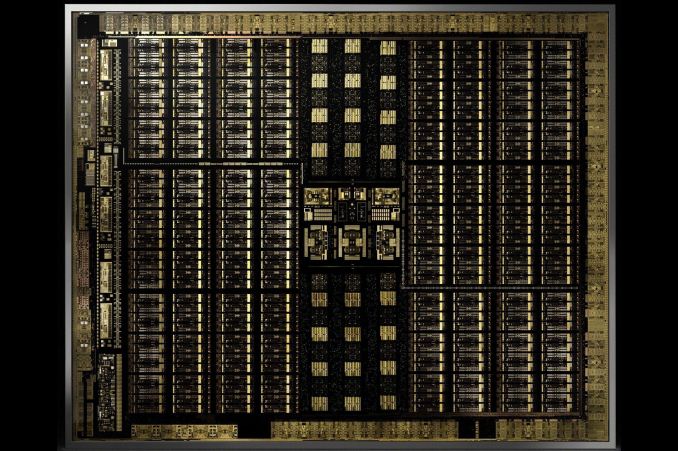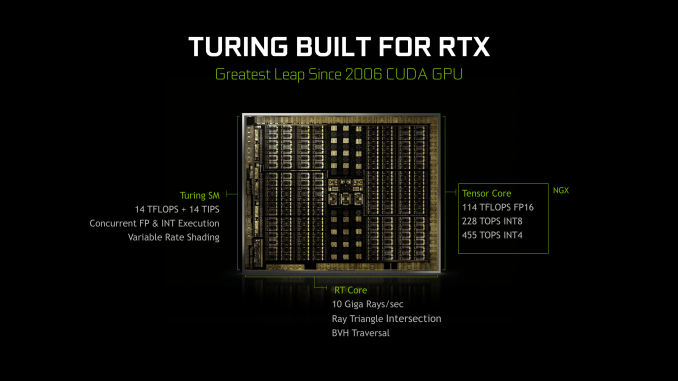The NVIDIA Turing GPU Architecture Deep Dive: Prelude to GeForce RTX
by Nate Oh on September 14, 2018 12:30 PM EST
It’s been roughly a month since NVIDIA's Turing architecture was revealed, and if the GeForce RTX 20-series announcement a few weeks ago has clued us in on anything, is that real time raytracing was important enough for NVIDIA to drop “GeForce GTX” for “GeForce RTX” and completely change the tenor of how they talk about gaming video cards. Since then, it’s become clear that Turing and the GeForce RTX 20-series have a lot of moving parts: RT Cores, real time raytracing, Tensor Cores, AI features (i.e. DLSS), raytracing APIs. All of it coming together for a future direction of both game development and GeForce cards.
In a significant departure from past launches, NVIDIA has broken up the embargos around the unveiling of their latest cards into two parts: architecture and performance. For the first part, today NVIDIA has finally lifted the veil on much of the Turing architecture details, and there are many. So many that there are some interesting aspects that have yet to be explained, and some that we’ll need to dig into alongside objective data. But it also gives us an opportunity to pick apart the namesake of GeForce RTX: raytracing.
While we can't discuss real-world performance until next week, for real time ray tracing it is almost a moot point. In short, there's no software to use with it right now. Accessing Turing's ray tracing features requires using the DirectX Raytracing (DXR) API, NVIDIA's OptiX engine, or the unreleased Vulkan ray tracing extensions. For use in video games, it essentially narrows down to just DXR, which has yet to be released to end-users.
The timing, however, is better than it seems. A year or so later could mean facing products that are competitive in traditional rasterization. And given NVIDIA's traditionally strong ecosystem with developers and middleware (e.g. GameWorks), they would want to leverage high-profile games for ringing up consumer support for hybrid rendering, which is where both ray tracing and rasterization is used.
So as we've said before, with hybrid rendering, NVIDIA is gunning for nothing less than a complete paradigm shift in consumer graphics and gaming GPUs. And insofar as real time ray tracing is the 'holy grail' of computer graphics, NVIDIA has plenty of other potential motivations beyond graphical purism. Like all high-performance silicon design firms, NVIDIA is feeling the pressure of the slow death of Moore's Law, of which fixed function but versatile hardware provides a solution. And where NVIDIA compares the Turing 20-series to the Pascal 10-series, Turing has much more in common with Volta, being in the same generational compute family (sm_75 and sm_70), an interesting development as both NVIDIA and AMD have stated that GPU architecture will soon diverge into separate designs for gaming and compute. Not to mention that making a new standard out of hybrid rendering would hamper competitors from either catching up or joining the market.
But real time ray tracing being what it is, it was always a matter of time before it became feasible, either through NVIDIA or another company. DXR, for its part, doesn't specify the implementations for running its hardware accelerated layer. What adds to the complexity is the branding and marketing of the Turing-related GeForce RTX ecosystem, as well as the inclusion of Tensor Core accelerated features that are not inherently part of hybrid rendering, but is part of a GPU architecture that has now made its way to consumer GeForce.
For the time being though, the GeForce RTX cards are not released yet, and we can’t talk about any real-world data. Nevertheless, the context of hybrid rendering and real time ray tracing is central to Turing and to GeForce RTX, and it will remain so as DXR is eventually released and consumer-relevant testing methodology is established for it. In light of these factors, as well as Turing information we’ve yet to fully analyze, today we’ll focus on the Turing architecture and how it relates to real-time raytracing. And be sure to stay tuned for the performance review next week!












111 Comments
View All Comments
Yojimbo - Saturday, September 15, 2018 - link
The sites I look at put $649 2013 dollars at about $700 today. They use the CPI, the Consumer Price Index. That is the standard way to compare values over consumer goods and cost of living in general between different years where the CPI has been recorded. I have no idea where the numbers in your chart have come from. For instance, by the CPI, the 7800 GTX 512, which was released in 2005, is about $840 in 2018 dollars, and $825 in 2017 dollars, far more than the $783 listed in your chart.Note that if you have a steady 2% inflation per year over 13 years you get a 29% increase in prices.
Yojimbo - Saturday, September 15, 2018 - link
And besides, your chart, even with the wrong numbers, doesn't show what you claim to show. The 780, the 280, the 8800 GTX, and the 7800 GTX all have launch prices around the RTX 2080, even though the RTX 2080 has a bigger die than any of them.eddman - Saturday, September 15, 2018 - link
Yes it does. 2080 Ti is the most expensive geforce launch card. It's not my job, as a buyer, to dig up die sizes or even care about them. I only care about performance/price ratios which these cards are terrible at.eddman - Saturday, September 15, 2018 - link
... they are terrible because the price/performance ratio hasn't improved in any substantial way. 1080 Ti offered ~70% performance increase over 980 Ti for just ~8% higher launch MSRP.Yojimbo - Saturday, September 15, 2018 - link
OK, so when GM produced the Hummer that's directly comparable to their Suburban because they were both SUVs. It's not your job to be an intelligent creature and realize that the Hummer opened up a new market segment. Instead, spend your energy resenting GM. You can do what you want but that doesn't make it rational.eddman - Sunday, September 16, 2018 - link
... except a Hummer is a Hummer and a Suburban is a Suburban. They are not part of the same lineup. Also, a car is not a video card.2080 Ti directly follows 1080 Ti based on the naming. It's not my fault they did it. They could've named it 2090 Ti if they really meant it to be a different product category, but they didn't so based on common branding logic 2080 Ti is the successor to 1080 Ti and therefore it is not out-of-the-ordinary to expect close pricing.
Rational? What I wrote is completely rational. It is you who is trying to somehow make it look that a ~42% price jump for a 40%-45% performance increase in regular rasterized games is ok. It is not. This is probably the worst generational price/performance ratio vs. the old gen I've seen.
eddman - Sunday, September 16, 2018 - link
... unless they plan on releasing GTX 2080 Ti/2080 at lower prices, but given the potential confusion that it might cause, probably not.0ldman79 - Sunday, September 16, 2018 - link
Oddly enough, going by that comparison the H2 is built on the same platform as the Suburban.Killmorefor - Sunday, September 16, 2018 - link
That chart is pretty accurate, but would benefit from a 3D showing price drops after the next gen introduction. The chart apples, and but does not show the price jump before the chart started, nor the current jump for the next gen the OP has very good point.markiz - Monday, September 17, 2018 - link
Yeah, so what?I don't understand.. If the price is too high, they will not sell much.